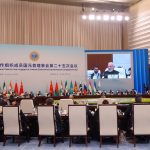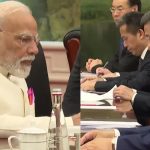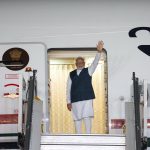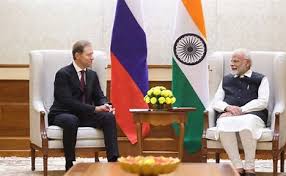 It’s time for Latin America in India and India in Latin America. Away from the noise of screaming headlines and geopolitical games, there will be quiet celebrations to toast the blossoming India-Latin America & the Caribbean relations in the Mexican city of Guadalajara, famed for tequila, peppy mariachi music and Indian IT companies. For two days (November 28-29), ministers, businessmen, entrepreneurs, policy-makers and analysts of India and over 25 LAC countries will gather in the bustling economic hub of Mexico to flesh out a robust vision of upscaling this crucial partnership that is bound by convergent interests and mutual goodwill.
It’s time for Latin America in India and India in Latin America. Away from the noise of screaming headlines and geopolitical games, there will be quiet celebrations to toast the blossoming India-Latin America & the Caribbean relations in the Mexican city of Guadalajara, famed for tequila, peppy mariachi music and Indian IT companies. For two days (November 28-29), ministers, businessmen, entrepreneurs, policy-makers and analysts of India and over 25 LAC countries will gather in the bustling economic hub of Mexico to flesh out a robust vision of upscaling this crucial partnership that is bound by convergent interests and mutual goodwill.
India-LAC Conclave: Business Synergy
 Separated by continental distances, but kindred in spirit and driven by a shared vision, India and Latin America, home to around 1.8 billion people, will be looking to ramp up their multi-faceted engagement and open new doors for mutually invigorating partnership. Defying downbeat trends in an uncertain global economic landscape, India, the world’s fastest growing economy, is betting big on Latin America, an emerging growth pole of the world, and vice-versa.
Separated by continental distances, but kindred in spirit and driven by a shared vision, India and Latin America, home to around 1.8 billion people, will be looking to ramp up their multi-faceted engagement and open new doors for mutually invigorating partnership. Defying downbeat trends in an uncertain global economic landscape, India, the world’s fastest growing economy, is betting big on Latin America, an emerging growth pole of the world, and vice-versa.
Together, both sides, fired by a can-do optimism, are determined to shape a narrative of opportunity and bring it to fruition. This emerging alchemy of economic and strategic interests between the two far-off but increasingly connected regions will be showcased and dissected at the first India-Latin America & Caribbean Conclave to be held in the LAC region. (for details see the conclave’s official website (http://www.ciiindialacconclave.in/)
 The Guadalajara conclave will build on the success of the previous six editions held in New Delhi which have helped crystallise new India-LAC business partnerships across the spectrum. The two-day meet is expected to culminate in a roadmap and plan of action for fructifying the immense potential of this burgeoning partnership.
The Guadalajara conclave will build on the success of the previous six editions held in New Delhi which have helped crystallise new India-LAC business partnerships across the spectrum. The two-day meet is expected to culminate in a roadmap and plan of action for fructifying the immense potential of this burgeoning partnership.
The choice of Mexico for hosting the conclave is apt for many reasons – it’s not only emerging as the top destination for India’s exports and hosts many Indian IT companies, but going back in history was the first LAC country to recognize India’s independence. “Mexico is the gateway to Latin America; it is the largest trading nation in the entire Latam region and has the second largest economy in the region with a stable macro-economic framework. Indian exporters, investors and business partners can take advantage of its strategic position, connecting it with NAFTA, as well as markets in South America, Central America and the Caribbean,” says Muktesh Pardeshi, India’s Ambassador to Mexico.
 Mexico is also part of the vibrant economic bloc, the Pacific Alliance, of which India is also an observer member. Significantly, the United Nations Economic Commission for Latin America and the Caribbean (UN ECLAC or CEPAL in Spanish) is co-partnering in hosting the conclave, along with CII, India’s Ministry of External Affairs and the Government of Jalisco, Mexico. “First and foremost, it establishes a forum to meet and create linkages to remove the awareness gap which exists today due to geographical distance. The Conclave is expected to serve as a platform for Indian and Latin American businesses to forge long term partnerships and enhance trade and investment relations. It is the most important economic diplomacy event aimed towards India-LAC connect,” says Ambassador Pardeshi.
Mexico is also part of the vibrant economic bloc, the Pacific Alliance, of which India is also an observer member. Significantly, the United Nations Economic Commission for Latin America and the Caribbean (UN ECLAC or CEPAL in Spanish) is co-partnering in hosting the conclave, along with CII, India’s Ministry of External Affairs and the Government of Jalisco, Mexico. “First and foremost, it establishes a forum to meet and create linkages to remove the awareness gap which exists today due to geographical distance. The Conclave is expected to serve as a platform for Indian and Latin American businesses to forge long term partnerships and enhance trade and investment relations. It is the most important economic diplomacy event aimed towards India-LAC connect,” says Ambassador Pardeshi.
Narrative of Opportunity
 It’s just the right time to aim high. The economic resurgence of India and Latin America are increasingly intersecting, opening new vistas for business and collaboration cutting across the spectrum. There is no far-off place when it comes to forging connections of heart, diplomacy or business. And nothing illustrates this better than the way India and Latin America have forged a dynamic evolving relationship pivoted around business, energy, food security, cultural synergy and strategic interests. The dramatic fall in oil and commodity prices has dented the economic outlook for the LAC region in the near term, but the overall sentiment remains one of optimism and possibility. With a combined GDP of over 4 trillion, the LAC region remains a formidable economic force. Besides, barring a few countries, the economies of most South American countries are growing rapidly, kindling new possibilities for business.
It’s just the right time to aim high. The economic resurgence of India and Latin America are increasingly intersecting, opening new vistas for business and collaboration cutting across the spectrum. There is no far-off place when it comes to forging connections of heart, diplomacy or business. And nothing illustrates this better than the way India and Latin America have forged a dynamic evolving relationship pivoted around business, energy, food security, cultural synergy and strategic interests. The dramatic fall in oil and commodity prices has dented the economic outlook for the LAC region in the near term, but the overall sentiment remains one of optimism and possibility. With a combined GDP of over 4 trillion, the LAC region remains a formidable economic force. Besides, barring a few countries, the economies of most South American countries are growing rapidly, kindling new possibilities for business.
Why Latin America Matters
The economic dynamism of the region is being bolstered by many factors that includes growing political stability, increasing democratisation, the growing middle class and the youth bulge, with the under 30s accounting for more than half of the population of South America. These big-picture trends have translated into a marked upswing in bilateral trade over the years, which has grown from $2 billion in 2001 to a peak of $49 billion in 2014, and cross-country investments amounting to around $23 billion. In the last couple of years due to the fall in oil prices and a dramatic reduction in diesel exports from India to the region, bilateral trade in terms of value has declined to around $31 billion, but analysts and businessmen of both sides are optimistic that this is a temporary downslide.
Win-Win Web
 The fact is that both India and Latin America have become increasingly important for each other as business destinations. Statistics can sometimes lie and mislead, but these numbers relating to exports and imports are revealing. Not many know that in 2015, India was, for Latin America, the largest destination of vegetable oil exports (26.6% of all vegetable oil exports went to India, and second-largest China had only 7.6%) and largest destination of soybean oil exports (44.58% of all soybean oil exports), making the region crucial to the country’s food security. Gold exports to India have been steadily rising, making the LAC region the fourth-largest destination of gold imports. Similarly, India remains the largest source of pharma and medicament mixtures imports for the LAC region. Indian motorcycles and cars are ubiquitous on the roads across the region, with India emerging as the second-largest source of motorcycle imports and eight-largest source of car imports. These vital statistics point to an increasing web of economic interdependence and indicate that bilateral trade will only scale new frontiers in days to come.
The fact is that both India and Latin America have become increasingly important for each other as business destinations. Statistics can sometimes lie and mislead, but these numbers relating to exports and imports are revealing. Not many know that in 2015, India was, for Latin America, the largest destination of vegetable oil exports (26.6% of all vegetable oil exports went to India, and second-largest China had only 7.6%) and largest destination of soybean oil exports (44.58% of all soybean oil exports), making the region crucial to the country’s food security. Gold exports to India have been steadily rising, making the LAC region the fourth-largest destination of gold imports. Similarly, India remains the largest source of pharma and medicament mixtures imports for the LAC region. Indian motorcycles and cars are ubiquitous on the roads across the region, with India emerging as the second-largest source of motorcycle imports and eight-largest source of car imports. These vital statistics point to an increasing web of economic interdependence and indicate that bilateral trade will only scale new frontiers in days to come.
Most important, the narrative of India in Latin America and that of the LAC in India has changed in the last few years, with each looking at the other as an attractive place for doing business. Says Hari Seshasayee, a Latin America analyst at CII: “Distances are no longer important and have been offset by many advantages of doing business with LAC. Trade costs have come down. Most South American countries are open economies. It’s easy to do business and people have higher purchasing power.”
Another major advantage for Indian companies looking to pitch their tent in the LAC countries is their strategic location which makes them hub for an extended region, granting access across the Atlantic and Pacific Oceans. “These countries serve as strategic hubs for accessing markets of US, North America and Europe. Many of them have free trade agreements with the US and Europe, which means duty-free access,” said Mr Seshasayee. Hero MotoCorp, for example, has set up its first international manufacturing plant in Colombia, which gives it market access not to just LAC, but also other ambient lucrative markets. In a gesture acknowledging India’s growing profile in the region, the plant, which seeks to produce 150,000 motorcycles per year, was inaugurated by President Juan Manuel in September 2015.
Brand India
 What’s uplifting for Indian companies is that ‘Brand India’ has acquired a visible public profile and has become synonymous with high quality and reliability. Bajaj, for example, has become a household name in countries like Colombia and Peru. Acquiring Pulsar motorcycle has become a symbol of status and upward mobility. A frequent traveller to the region says that in many South American countries, the whole family goes together to check out and buy Pulsar motorcycle. Indian generic drugs are a byword for quality and their affordability makes them more attractive and popular.
What’s uplifting for Indian companies is that ‘Brand India’ has acquired a visible public profile and has become synonymous with high quality and reliability. Bajaj, for example, has become a household name in countries like Colombia and Peru. Acquiring Pulsar motorcycle has become a symbol of status and upward mobility. A frequent traveller to the region says that in many South American countries, the whole family goes together to check out and buy Pulsar motorcycle. Indian generic drugs are a byword for quality and their affordability makes them more attractive and popular.
Indian investments in the LAC region have been widely welcomed not only because they bring in capital and enterprise, but also due to its employment prospects and integration into local supply chains. Indian IT companies, according to an estimate, currently employ around 25,000 locals in Latin America. “In terms of investment, Indian companies in Latin America have tended to behave far more like Western multinationals than have their Chinese counterparts, employing local managers and workers, and integrating local producers into their supply chains,” writes Evan Ellis, a well-known Latin America expert.
 The image of India has changed in the region, especially in the last few months since the Indian government embarked on path-breaking second generation economic reforms. The easing of FDI restrictions in crucial sectors like defence and insurance and the passing of the landmark Goods and Sales Tax legislation has bolstered the confidence of the region in the India growth story.
The image of India has changed in the region, especially in the last few months since the Indian government embarked on path-breaking second generation economic reforms. The easing of FDI restrictions in crucial sectors like defence and insurance and the passing of the landmark Goods and Sales Tax legislation has bolstered the confidence of the region in the India growth story.
The situation is, therefore, ripe for pushing the envelope and scale up the business relationship to new heights. The 7th India-LAC conclave seeks to precisely achieve this and has zeroed in on a focused agenda revolving around easing of trade barriers, increasing investment and enhancing trade financing. In this regard, the discussions on the role of regional groups and trade agreements in the India-LAC relationship will be crucial. India has already signed trade agreements with Mercosur and Chile, and is negotiating a similar agreement with Peru. The conclave should map the way forward on how India can work closer with the Pacific Alliance and will explore the ramifications of TPP on the India-LAC ties. R. Vishwanathan, a former Indian ambassador to Argentina and Latin America enthusiast, suggests that India should sign free trade agreements (FTAs) with Mexico, Colombia and Peru, leading destinations of India’s exports in Latin America. “India must also deepen and widen the preferential trade agreements (PTAs) with Chile and Mercosur countries including Brazil—the largest destination of India’s exports in the region,” he suggests.
Besides the existing core areas of India-LAC business collaboration including information technology, pharmaceuticals, energy, automobiles, and agribusiness, the conclave will also focus on emerging frontiers like renewable energy and space. Driven by India’s Focus LAC programme, development partnership is growing. India has indicated its willingness to share its technology in e-governance, tele-education and tele-medicine and has offered to provide weather forecasting and mapping of mineral resources in LAC region.
Thinking Global
Above all, the India-Latin America relations are set to acquire a deeper strategic complexion. Building upon New Delhi’s maiden dialogue with a troika of foreign ministers of the Community of Latin American and Caribbean States (CELAC) in July 2012, the two sides are exploring possibilities of forging an India-Latin America and Caribbean Dialogue Mechanism similar to that of the India-Africa Forum Summit that started in 2008. The region is also critical to the ongoing drive for reforming the global governance architecture, including the reform and expansion of the UN Security Council, and India’s ambition to become a member of the Nuclear Suppliers Group. Many South American countries, including Brazil, Argentina and Mexico, are members of the NSG and their support will be crucial to New Delhi’s membership of the exclusive nuclear club.
The Modi Factor
 By any reckoning, the vibrant and resource-rich Latin America region is set to zoom higher in New Delhi’s diplomatic calculus in months to come. The Modi government has made a good start as barely a couple of months after taking charge, Prime Minister Narendra Modi visited Brazil in July 2014 for the BRICS summit and held the first of its kind outreach meeting with 11 leaders of South American countries, which included Presidents of Argentina, Bolivia, Chile, Colombia, Ecuador, Guyana, Paraguay, Peru, Suriname, Uruguay and Venezuela.
By any reckoning, the vibrant and resource-rich Latin America region is set to zoom higher in New Delhi’s diplomatic calculus in months to come. The Modi government has made a good start as barely a couple of months after taking charge, Prime Minister Narendra Modi visited Brazil in July 2014 for the BRICS summit and held the first of its kind outreach meeting with 11 leaders of South American countries, which included Presidents of Argentina, Bolivia, Chile, Colombia, Ecuador, Guyana, Paraguay, Peru, Suriname, Uruguay and Venezuela.
 This was the first interaction of an Indian PM with the leaders of South America on such a scale. Since then, there have been many high-profile two-way visits, including the much publicised visit by PM Modi to Mexico this year. More high-level visits and engagements, in sync with the new Indian government’s emphasis on diplomacy and dialogue, are on the way.
This was the first interaction of an Indian PM with the leaders of South America on such a scale. Since then, there have been many high-profile two-way visits, including the much publicised visit by PM Modi to Mexico this year. More high-level visits and engagements, in sync with the new Indian government’s emphasis on diplomacy and dialogue, are on the way.
The Long View
Looking ahead, the multi-faceted partnership between India and LAC region is set to deepen due to a host of interlinked economic and strategic imperatives. The LAC region is poised to grow in importance for India’s energy security as it currently accounts for around 18-20 per cent of India’s oil imports. Besides hydrocarbons, new avenues are set to be opened in areas of clean and green energy. Venezuela, Colombia, Mexico and Cuba are set to be important suppliers of oil to India in the region.
 Intertwining India and the LAC region, the hardware of economic engagement is complemented by the software of cultural affinities and connections. Soccer, samba and story-telling for which Latin America is famous for blends beautifully with Indian cultural forms, Bollywood, music and spiritual practices like yoga. “They simply love Indian culture. There are more yoga centres in Brazil than in India,” says Hardeep Singh Puri, India’s former ambassador to Brazil.
Intertwining India and the LAC region, the hardware of economic engagement is complemented by the software of cultural affinities and connections. Soccer, samba and story-telling for which Latin America is famous for blends beautifully with Indian cultural forms, Bollywood, music and spiritual practices like yoga. “They simply love Indian culture. There are more yoga centres in Brazil than in India,” says Hardeep Singh Puri, India’s former ambassador to Brazil.
Blending diplomacy with business and culture with connectivity, the India-LAC relations are set to move onto a higher stratosphere. In the region in which myths intersect with reality effortlessly, generating magical moments, some focused pragmatic steps combined with inspired diplomacy can widen the arc of the India-LAC partnership and help fructify new dreams and new possibilities inherent in this burgeoning relationship. It’s time to tango, and match steps, as they say out there.
(Manish Chand is Founder-CEO and Editor-in-Chief of India Writes Network, www.indiawrites.org, an e-magazine and journal focused on international relations, and TGII Media Private Limited, a media, publishing and consultancy company)
Author Profile

- Manish Chand is Founder and Editor-in-Chief of India Writes Network (www.indiawrites.org) and India and World, a pioneering magazine focused on international affairs. He is CEO, Centre for Global India Insights, an India-based think tank focused on global affairs.
Latest entries
 India and the WorldOctober 2, 2025With US frowning, India to host Putin in December
India and the WorldOctober 2, 2025With US frowning, India to host Putin in December India and the WorldSeptember 1, 2025Tianjin boost for India: SCO rises against cross-border terror
India and the WorldSeptember 1, 2025Tianjin boost for India: SCO rises against cross-border terror India and the WorldAugust 31, 2025Message from Modi-Xi meeting: It’s the right choice to engage and be friends
India and the WorldAugust 31, 2025Message from Modi-Xi meeting: It’s the right choice to engage and be friends DiplomacyAugust 29, 2025Ahead of China visit, Modi eyes Japan opportunity
DiplomacyAugust 29, 2025Ahead of China visit, Modi eyes Japan opportunity







